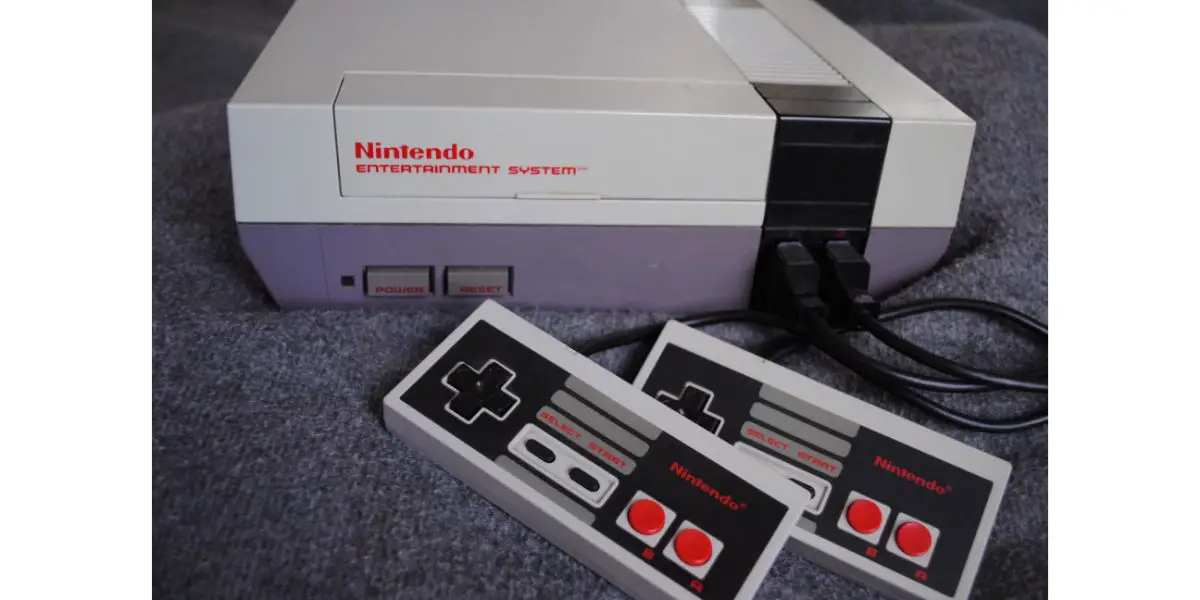Disclaimer: This post may contain affiliate links, meaning we get a small commission if you make a purchase through our links, at no cost to you. For more information, please visit our Disclaimer Page.
The Nintendo Entertainment System represents the company’s take on the third generation of game consoles, and it was part of a wider release in the 1980s. Nintendo had developed arcade games before the release of the NES, and the business opted to reuse a simple controller design that it carried over from some of the portable games of the past.
The result turned out to be a wildly popular 8-bit home console that had a direct impact on bringing the video game industry at large back from a crash. Many in the tech industry attribute this success to the simple, inexpensive design of the original Nintendo, the variety of add-on peripherals gamers could use with it, and the library of fun. These exciting titles were of much better quality than many other games on the market.
Nintendo’s president at the time wanted games stored on cartridges to keep costs down. Although these units are durable and long-lived, some contemporary players may notice issues when trying to run them. We will attempt to answer some of the broader questions about NES cartridges. As we do, we can try to troubleshoot some things that could cause them to stop working.
Table of Contents
Do NES Games Stop Working?
Because of the nature of the cartridges, NES games are robust. When you treat them properly, they should be able to withstand more neglect or similar issues than console games using the optical disc storage of today.
However, that doesn’t mean that all Nintendo games can keep working indefinitely. Some circumstances can cause a cartridge to behave erratically or cease working altogether.
In some cases, the issue may be temporary, and there are ways that you might correct the problem. Should the damage or problem be severe enough, you may have a dead cartridge on your hands. There are a few signs you can look for to see if this might be the case, but the original Nintendo is an old system with many years of community knowledge and support.
Thanks to this, several possible troubleshooting tips are available to help you. We will talk about some of the main things you can do here. Our suggestions here assume that something is wrong between the cartridge and console that prevents gameplay.
1. Give the Cartridges a Deep Clean
Some people in the Nintendo community may advise you to blow into the bottom of the cartridge. The idea here is to remove pesky dust or debris that could interfere with the game making a solid connection to the console itself.
This method is certainly a good first step; it may be all you need to do to get a title working again. However, if this doesn’t suffice, a deeper cleaning job may be necessary.
For the cartridges, you can try using a cotton swab to get into places that would be harder for other tools to reach. Take the swab and dip it in rubbing alcohol to soak it.
Your gaming cartridge has contacts made of metal. These contacts need a solid connection to parts of the Nintendo console for a game to work. To remove possible obstructions, you’ll want to rub the cotton swab across these contact points gently.
We recommend that you repeat this process with different swabs dipped in the solution until you notice that the cotton seems quite clean after you rub it on the cartridge. Once done, you can dry the contact points and see if the game will work.
2. Clean the Console
If taking care of the cartridge itself doesn’t seem to work, it is time to look at the Nintendo console. You’ll need to open up the console to do this cleaning. Take care when you do so not to damage anything inside.
Additionally, ensure you know how to close everything up again before you begin. Once you open the unit, you can look for signs of dust inside the compartment where you would usually insert a gaming cartridge.
Instead of a cotton swab, you’ll need to use something thin to get down into the crevices here. A thin, clean piece of cloth should do nicely, and you can wrap the portion you use in a rigid card or other square to give it some shape.
Before you wrap it, soak the cloth in some rubbing alcohol. Once done, you can put the square piece of fabric inside the space where you would insert a cartridge. The goal is to clean the pins and connectors that make contact with the game. Press the fabric into this area until you notice that it comes out without any dirt on it. Now you can try your cartridge again to see if it works.
3. Replace the Pin Connector
Unfortunately, there is a chance that these methods may not work. If they don’t, you could be dealing with a deeper problem than a little dust. One of the next steps you can take is to replace the connector part of the console itself.
The original Nintendo console used a connector with 72 pins to communicate with a game cartridge. Because the technology is older, you should be able to find replacements for fairly inexpensive price points on the secondary market. You can try installing a new connector to see if that solves the problem.
Why Do NES Games Flicker?
You may notice that the screen flickers when you play a Nintendo game. Unlike blinking on or off, this sort of thing usually manifests as lines that go across the screen very rapidly. These lines seem to go over the top of the otherwise static, colorful imagery the main game produces. To understand why the flickering effect can happen, it is necessary to detail how the programmers make Nintendo games work.
Due to technology limitations, when the developers released the console could only handle what we would consider simple graphics today. For each frame of the game, the unit produced things called sprites.
Together, the sprites would make up the different images, backgrounds, or characters you would see as you played a game. However, the processor in the console could only render a set maximum of sprites. If a game attempted to create more than this number, some of the sprites would not be visible.
Invisible sprites could be a problem if some of those sprites made up enemies for you in the game. The game developers changed the sprite order in the lists they programmed to ensure this would not be a problem.
Doing so meant that which sprites would be invisible would change with each frame the game rendered. The effect would look like flickering bars going across the screen.
How Many Sprites Could the NES Display?
The Nintendo uses a picture processing unit. Otherwise, something people in the industry call a PPU, to display the images in the games you play. This processor could display up to 64 sprites for every game frame it rendered. Additionally, it could render eight sprites for every horizontal line.
Why Are NES Cartridges So Big?
There are several possible reasons that Nintendo may have considered when designing the cartridges for their console games. Although we may not know the exact answers, we can make some educated guesses. One of the simpler explanations is that the company wanted gamers to feel like they were holding something substantial.
To facilitate this, they made the cartridges large, possibly bigger than they needed to be for storing game data. This decision may have been one the company came to due to the crash in the market during the years leading up to the console’s release. The look of the large cartridge made it appealing to some consumers.
Otherwise, the company also wanted it to be easy for younger gamers to take out and put in the console with ease, making a large cartridge a good design choice. Because the NES used a lot of pin connectors, Nintendo also needed to create a short, wide card that could accommodate those pins. The result was the bulky Nintendo cartridge that you see today.
Can You Play NES Games on the SNES?
Technically, there is a way to play some NES games on the Super Nintendo system. However, you cannot do this natively, meaning there is no original backward compatibility between the two systems.
Instead, you may be able to find adapters that are clones of regular Nintendo cartridges. These adapters use the Super Nintendo for controller capabilities and power but utilize processing power and display output.
Are NES Games Region-Locked?
Yes, some Nintendo games come with chips which means they are for particular consoles released in those regions. The classic version of the original Nintendo did not have a lock on its region, but there were still many versions of it that the company produced for specific areas. Cartridges, too, could have region-locking on them. You would need to purchase a compatible cartridge for the console.
Conclusion
The standard Nintendo console helped to revitalize gaming in the 1980s. In doing so, the company created several new, fresh titles that gamers still remember and play today. If they cannot access an original Nintendo, they may even create emulators to mirror the experience of the real thing. While some Nintendo cartridges may stop working over time, you can usually clean them to get them back in good condition.


